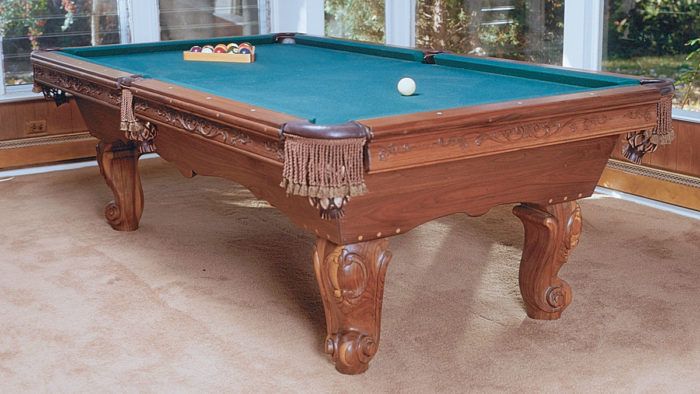Building a Pool Table
Starting from scratch with nuts-and-bolts joinery
Synopsis: Building a pool table is somewhat intimidating, Paul M. Bowman admits, because of the size and the weight it must support. However, it doesn’t involve anything that’s beyond a weekend woodworker with the gumption to take on a large project. The table he explains how to make is built much like high-end commercial pool tables. Each section of the three-piece slate is glued to a wood liner and then screwed, but not glued, to the main table body, a box whose sides incline down and in at 15 degrees. He explains how to do that, how to screw and glue a 2×8 leg support, and attach the legs with lag screws or hanger bolts. Then he talks about how to bolt on the rails, which support the cushions and pockets, and an apron (or blind, as it’s called on pool tables). Side information discusses covering the rails and slate bed.
The distinctive crack of the break, brightly colored balls rolling across the expanse of green and the “plop” of the ball dropping into the pocket-these are the sights and sounds of satisfaction to pool afficionados. But, few of them have the satisfaction of sinking balls into pockets on a table they’ve built themselves.
Building a pool table is somewhat intimidating, because of the size of the table and the weight it must support. In addition to the 400-lb. slate playing surface, a pool table must be able to support a person sitting on the edge while attempting a behindthe-back shot. On the other hand, aside from the compound angles, building a pool table doesn’t involve anything that’s beyond a competent weekend woodworker with the gumption to take on a large project.
The table described here is constructed much like many highend commercial pool tables (see figure 1, above). Each section of the three-piece slate is glued to a wood liner and then screwed, but not glued, to the main table body, a box whose sides incline down and in at 15°. A 2×8 leg support is screwed and glued between the sides at each end of the box. The four legs are attached to these supports with lag screws or hanger bolts. Bolted on top of the slate are six rails, which support the cushions and pockets. An apron, or blind as it’s called on pool tables, surrounds the rails and covers the edge of the slate assembly.
The choice of wood, the carving or other decoration on the table and the style of legs can be custom designed to suit an individual’s tastes. But one thing is certain: The table must fit the slate, so buy the slate before you begin working. The slate comes from Italy or Spain, where it is cut to size and the pocket cutouts and holes are drilled for assembly hardware. The chart on the facing page lists common slate sizes, weights and playing areas. Unless you’re buying 100 or more sets, you’ll need to locate a local pool-table dealer in your area who is willing to sell you a single set. Don’t buy slate that is not predrilled.
From Fine Woodworking #75
For the full article, download the PDF below:
Fine Woodworking Recommended Products

Stanley Powerlock 16-ft. tape measure


Drafting Tools




















Log in or create an account to post a comment.
Sign up Log in